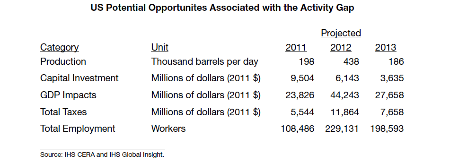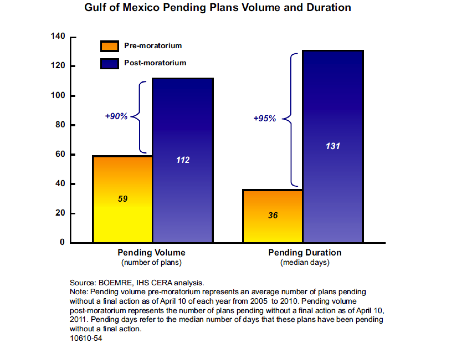The Obama Administration has long been hostile to domestic oil and natural gas production. The impacts of these policies are becoming clear. One recent study found that the Administration’s moratorium and slowdown in permitting in the Gulf of Mexico has cost the United States over $4 billion in economic output and nearly 20,000 jobs.[i] A new study has found that there is great economic potential if the Administration speeds up their slow permitting process.
The Gulf Economic Survival Team, a group of energy and business interests based largely in Louisiana, had IHS Global Insight and IHS CERA study the impact of faster permitting of oil leases on offshore oil production and the economies of the United States and affected states.[ii] They determined that increased exploration and permitting approval in 2012 would:
- Create 230,000 U.S. jobs
- Increase U.S. GDP by more than $44 billion
- Increase tax and royalty revenues for state and federal treasuries by almost $12 billion
- Increase oil production by more than 400,000 barrels per day (150 million barrels per year)
- Reduce U.S. payments for oil imports by about $15 billion.
Other findings are:
- Almost twice the number of exploration and development plans are pending from the Department of Interior compared to pre-moratorium levels
- Approvals of exploration plans have decreased by 85 percent.
- The median number of days for approving an exploration plan has increased from 36 days to 131 days.
Further, ten oil rigs have left the Gulf of Mexico since the moratorium for more lucrative areas offshore in Egypt, Congo, French Guiana, Liberia, Nigeria, and Brazil.[iii] Although federal officials announced they were lifting the restrictions last October on a moratorium put in place in May 2011, a “de-facto moratorium” remains in effect that lowers oil and natural gas production and impacts businesses in the Gulf region.
The IHS Global Insight and IHS CERA Study
This study evaluated the pace of permitting offshore leases in the Gulf of Mexico by the Bureau of Ocean Management, Regulation and Enforcement (BOMRE), an organization in the Department of Interior. The period of review was from the end of the moratorium on offshore drilling by the Obama Administration in October 2010 until April 30, 2011, 6 months of data. They found that the number of pending exploration and development plans submitted to BOEMRE that have not received final action has increased by almost 90 percent from historical levels. The median number of days a plan is pending approval has increased from 36 days to 131 days. They also found that exploration and development plan approvals are down by more than 85 percent and approvals of drill permits covered by those plans are down by almost 65 percent. The slower pace of approvals will make other investment opportunities more advantageous for the industries involved. Already ten rigs have left the area for opportunities in other areas of the world.
After the spill and the reorganization of the Minerals Management Service into BOMRE, new safety and environmental rules were issued, probably causing a slowdown to both the number of applications and to the approval process. This study, however, did not determine the causes for the slowdown nor what actions should be taken to fix it. Rather the study evaluated the impact of approving permits faster and reducing the backlog of the permits currently in the pipeline, finding that employment and tax royalty revenues would increase and energy security would improve from the increased production. The results of their analysis are shown in the table below.

Employment would not only increase in the Gulf States, but in states such as Florida, Georgia, California, Illinois, and Pennsylvania. Louisiana’s potential increased revenues of $1.3 billion would cut its budget shortfall by more than 80 percent. The state results are provided below.
The report’s message is that the output of BOEMRE in regard to regulatory oversight and responsiveness should be aligned with the level of investment that oil companies are willing to make in the Gulf. For instance, in June, Exxon Mobil announced a new discovery in the Keathley Canyon area of the Gulf with recoverable oil estimated at 700 million barrels and Shell announced plans to invest $2.5 billion in its Cardamon field in the Gulf.[iv] Just the royalty to the federal treasury from Exxon’s find at today’s oil price is more than $13 billion.
It generally takes seven to ten years from exploration and development to initial production. And not all drilling activity results in oil production. Generally, only one in seven wells will result in economically viable reserves. So, in order to keep production at or above current levels, it is crucial for exploration to continue at historic rates.
Government’s Expectation of Offshore Oil Production
The Energy Information Administration (EIA) forecasts oil production over the next two years in its Short Term Energy Outlook, which it releases each month. In its latest outlook, the EIA is predicting that offshore oil production in the Gulf of Mexico will fall from 1.7 million barrels per day in January 2010 to 1.34 million barrels per day in December 2012, a drop of 360,000 barrels per day.[v] Prior to the Deep Water Horizon accident and the Obama Administration moratorium, the EIA was forecasting fairly robust oil production from the Gulf at levels averaging 1.7 million barrels a day in 2010 and 2011. Now, the 2011 forecast for offshore oil production from the Gulf of Mexico is reduced to about 1.5 million barrels per day.[vi] Note that the end of the forecast horizon in EIA’s April 2010 Short-Term Energy Outlook was 2011, so comparisons regarding the 2012 offshore oil production numbers cannot be made from a prior forecast.
Conclusion
Studies are showing that we are losing oil production from the Gulf of Mexico from the Obama Administration’s moratorium and its continuing slowness in approving permits or a “permitorium”. The study by IHS Global Insight and IHS CERA is indicating that there are great economic gains to be reaped if the Administration speeds up their slow permit process. But, the reality is that a slowdown is occurring with the resultant impact of less employment, less government tax revenues, less oil production, and less energy security.
[i] Testimony of Joseph R. Mason, Louisiana State University, before the Subcommittee on Energy and Power, Committee on Energy and Commerce, U.S. House of Representatives, March 17, 2011, http://republicans.energycommerce.house.gov/Media/file/Hearings/Energy/031711/Mason.pdf
[ii] IHS Global Insight and IHS CERA, Restarting the Engine: Securing American Jobs, Investment, and Energy Security, July 21, 2011, http://www.ihs.com/images/IHS_Report_Restarting_the_Engine_21July11.pdf
[iii] The Pelican Post, Ten Oil Rigs Have Exited Gulf Since Obama Moratorium Went into Effect, July 20, 2011, http://www.thepelicanpost.org/2011/07/20/ten-oil-rigs-have-exited-gulf-since-obama-moratorium-went-into-effect/
[iv] Chron, 230,000 more jobs if permits speeded?, July 21, 2011, http://www.chron.com/disp/story.mpl/business/energy/7664174.html#ixzz1SpvjIQA3
[v] Energy Information Administration, Short Term Energy Outlook, July 12, 2011,
[vi] Energy Information Administration, Short-Term Energy Outlook, April 2010, http://www.eia.gov/emeu/steo/pub/archives/apr10.pdf
